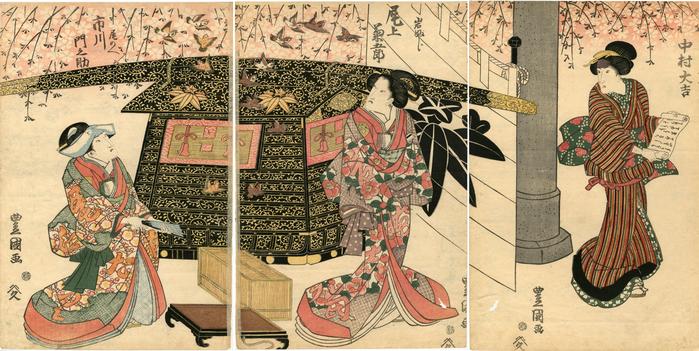Utagawa Toyokuni I (初代歌川豊国) (artist 1769 – 02/24/1825)
Scene from Botan ni cho itsuka fumibako (牡丹蝶初筐) - Nakamura Daikichi I (中村大吉) on the right as Ohatsu (おはつ), Onoe Kikugorō III (尾上菊五郎) as Iwafuji in the center, and Ichikawa Monnosuke III (市川門之助) on the left as Onoe
ca 1823
29.25 in x 14.5 in (Overall dimensions) color woodblock print
Signed: Toyokuni ga (豊国画)
Publisher: Yamamotoya Heikichi
(Marks 595 - seal 04-007)
Censor's seal: kiwame
Victoria and Albert Museum - the full triptych Toita Yasuji in 1969 wrote that "...the scenes of cherry blossom viewing in Shin Usuyuki Monogatari and Kagamiyama Kokyō no Nishikie [are] the two most famous cherry blossom scenes in Kabuki."
Quoted from: Kamikaze, Cherry Blossoms, and Nationalisms: The Militarization of Aesthetics in Japanese History by Emiko Ohnuki-Tierney, fn. 19, p. 36.
****
In a description of the similar 1824 triptych by Toyoshige, Toyokuni I's student, at the British Museum the curatorial files say: "The kabuki actors Ichikawa Danjuro VII as Iwafuji standing in front of a palanquin, holding one end of a straw sandal (right sheet), Iwai Shijaku I as Onoe (mitate Onoe) kneeling, holding the other end of the sandal (centre), and Iwai Hanshiro V watching on from behind a votive stone lantern, seated, holding a letter scroll; a version of the 'Sandal beating scene' (zori uchi no ba), from the play 'Botan ni cho itsuka fumibako (alternate reading 'Botan ni cho hatsu ga fumibako), also called 'Zoho Kagamiyama', by Tsuruya Nanboku IV; performed at the Ichimura-za in the 3rd month of 1824. The characters are depicted in front of a black lacquered palanquin set down before the entrance to a shrine with a flowering cherry tree in the background."
****
Like most kabuki plays known today only a few acts of this play have been preserved and are still being performed. In volume 2 of Kabuki Plays on Stage..., edited by James Brandon and Samuel Leiter, there is a discussion and translation of Kagamiyama Kokyō no Nishikie, pp. 172-212.
There are four other prints in the Lyon Collection showing the figure of Iwafuji.
****
Based on true events, Iwafuji, jealous of the beauty of a younger but less privileged woman, Onoe, unjustly humiliates her. Onoe felt that the only honorable thing she could do was to commit suicide. Onoe's maid, Ohatsu, got revenge for his mistress by eventually killing Iwafuji.
The right-hand panel of this triptych in the Lyon Collection is trimmed slightly on the right side. We know this by comparing it with the copy of this triptych in the Victoria and Albert Museum where the same panel clearly shows the name of Ohatsu, Onoe's handmaid, on the far right.
****
Iwafuji often wears an outfit referred to as a katahazushi. "The costume of the upper-class samurai wife and the goten juchū (ranking lady-in-waiting) at the courts of the shōgun and the daimyō - but not at the imperial court - is referred to as the katahazushi ishō... because these women wear the wig with the asymmetrical, topknot known as the katahazushi mage (kata, one side; hazushi, unfastened, disconnected; mage, topknot."
Onoe Kikugorō III (三代目尾上菊五郎: 11/1815-3/1848) (actor)
Ichikawa Monnosuke III (三代目市川門之助: 11/1815 to 1824) (actor)
Nakamura Daikichi I (初代中村大吉: from 1800 to 3/1823) (actor)
actor prints (yakusha-e - 役者絵) (genre)
Yamamotoya Heikichi (山本屋平吉) (publisher)
Iwafuji, Onoe, Ohatsu (岩藤, 尾上, お初) (role)
Keisei Kagamiyama (けいせい双鏡山) (kabuki)
Tsuruya Nanboku IV (四代目鶴屋南北) (author)
